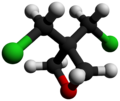3,3-Bis(chloromethyl)oxetane (BCMO) is an intermediate in the synthesis of poly(bis(azidomethyl)oxetane (PolyBAMO), an energetic polymer that is being studied for use as a propellant binder for rocket fuel.[2]

| |||

| |||
| |||
| Names | |||
|---|---|---|---|
| Preferred IUPAC name
3,3-Bis(chloromethyl)oxetane | |||
| Other names
3,3-Dichloromethyloxycyclobutane
BCMO | |||
| Identifiers | |||
3D model (JSmol)
|
|||
| ChemSpider | |||
| ECHA InfoCard | 100.001.033 | ||
| EC Number |
| ||
PubChem CID
|
|||
| UNII | |||
CompTox Dashboard (EPA)
|
|||
| |||
| |||
| Properties | |||
| C5H8Cl2O | |||
| Molar mass | 155.02 g·mol−1 | ||
| Appearance | Black or olive green solid[1] | ||
| Density | 1.295 g/cm3 | ||
| Melting point | 18.9 °C (66.0 °F; 292.0 K)[1] | ||
| Boiling point | 95 °C (203 °F; 368 K) | ||
| Hazards | |||
| GHS labelling: | |||
 
| |||
| Warning | |||
| H302, H315, H319, H330, H335 | |||
| P260, P264, P270, P271, P280, P284, P301+P312, P302+P352, P304+P340, P305+P351+P338, P310, P320, P321, P330, P332+P313, P337+P313, P362+P364, P403+P233, P405, P501 | |||
| NFPA 704 (fire diamond) | |||
Except where otherwise noted, data are given for materials in their standard state (at 25 °C [77 °F], 100 kPa).
| |||
It is classified as an extremely hazardous substance in the United States.[3] It can cause kidney damage, lacrimation, and somnolence if consumed.[1]
Preparation and reaction
editBCMO is formed in solution via cyclization of pentaerythritol trichlorohydrin with a non-organic base like sodium hydroxide.[4]
BAMO can be formed from a reaction of BCMO with sodium azide. This reaction takes place in an alkaline solution with tetrabutyl ammonium bromide, which acts as a phrase transfer catalyst.[4]
References
edit- ^ a b c Oxetane, 3,3-bis(chloromethyl)- at hazmap.nlm.nih.gov.
- ^ [2]http://www.dtic.mil/dtic/tr/fulltext/u2/a377866.pdf Archived 2018-08-20 at the Wayback Machine
- ^ "40 C.F.R.: Appendix A to Part 355—The List of Extremely Hazardous Substances and Their Threshold Planning Quantities" (PDF) (July 1, 2008 ed.). Government Printing Office. Archived from the original (PDF) on February 25, 2012. Retrieved October 29, 2011.
- ^ a b Pisharath, Sreekumar; Ang, How Ghee (2007). "Synthesis and thermal decomposition of GAP–Poly(BAMO) copolymer". Polymer Degradation and Stability. 92 (7): 1365–1377. doi:10.1016/j.polymdegradstab.2007.03.016.


